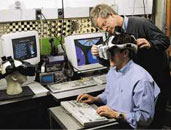HOUSTON – Work and life on the International Space Station may sound glamorous, but simply moving from one section of the spacecraft to another could create real problems for future crews.
Life without gravity can cause astronauts to become disoriented and, possibly, suffer space motion sickness. Also, inner-ear and disorientation problems can lead to confusion when performing simple tasks such as reaching for a control or finding a tool.
“Our bodies are designed for Earth’s gravity, and gravity tells our brain which way we are oriented,” said Dr. Charles Oman, head of the National Space Biomedical Research Institute’s (NSBRI) Sensorimotor Adaptation Team. “In space, your perception of down is constantly changing as you rotate in the weightless environment. Disorientation occurs because, without gravity, the inner ear no longer provides the brain with information about the body’s ‘up’ or ‘down’ position.”
Oman is leading a group of NSBRI researchers trying to remedy disorientation problems by investigating how a person uses their sense of where they are relative to other objects and places. The group is developing a virtual-reality training tool to help astronauts learn techniques and pre-flight strategies they can apply in space to help them work their way through a large and complex space vehicle. This spatial disorientation can also cause problems if astronauts need to exit the station in an emergency.
The Virtual-Reality Orientation and Navigation Trainer is a head-mounted display that shows generic computer-generated virtual-reality scenes. Users traverse a route through several modules and then must indicate the direction home. The device tests how crewmembers maintain orientation and learn to navigate within a spacecraft.
“You have to use tricks to learn an area’s layout, such as choosing what distinguishing landmarks you can within the station, that will help you understand your orientation with respect to each module,” said Oman, who is also director of the Man Vehicle Laboratory at the Massachusetts Institute of Technology. “Space stations tend to be visually ambiguous as the walls, ceiling and floors are similar in color and size. Ideally, each module should have cues to help the astronaut maintain a sense of up and down when moving between modules.”
The group is also investigating the inner-ear factors that leave astronauts in another potentially perilous position. With nothing in their visual field below them – except for Earth hundreds of miles below – astronauts on spacewalks or on the robotic arm have reported high-anxiety levels and the sense of falling even though logic tells them they won’t.
Members of Oman’s team are also working with investigators at NASA to develop a marking system that will help lead astronauts to crew-return vehicles if an emergency occurs.
The sensorimotor team’s work is complemented by NSBRI teams looking at other space health concerns such as bone loss, cardiovascular changes, muscle wasting, sleep disturbances, radiation exposure, infections and immune response. While focusing on space health issues, the institute will quickly transfer the solutions to Earth patients suffering from similar conditions.
The NSBRI’s consortium members include Baylor College of Medicine, Brookhaven National Laboratory, Harvard Medical School, The Johns Hopkins University, MIT, Morehouse School of Medicine, Mount Sinai School of Medicine, Rice University, Texas A&M University, University of Arkansas for Medical Sciences, University of Pennsylvania Health System and University of Washington.
###






